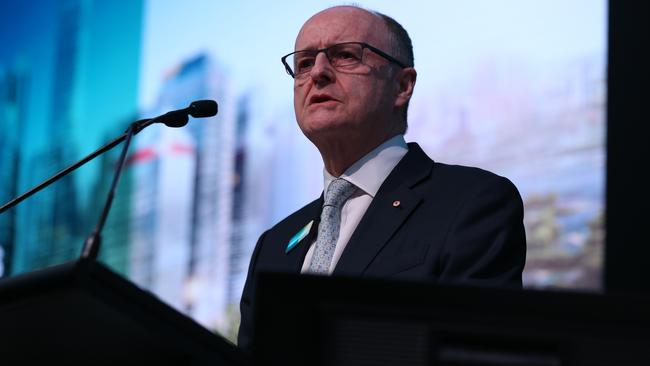
He had come to Australia in the 1950s with Dutch construction firm Bredero’s Bouwbedrijf, which went on to build worker housing for the Snowy Mountains Scheme, setting up Civil & Civic as a subsidiary of the company.
Civil & Civic then went on to lead to the formation of the Lend Lease Corporation in 1958 which he chaired until his retirement in 1988. His company soon made its mark in Australia by building the podium for the Sydney Opera House and Caltex House on Sydney’s Circular Quay.
One of those who answered his call was my father, a Dutchman who migrated to Australia in the 1950s, having lived as a teenager through the war and then had several years of conscription, and was convinced that there was no future for him in his economically depressed homeland.
My father would come home from work full of enthusiasm about his charismatic Dutch boss, whose social democrat views contrasted with the more conservative pro-English establishment of corporate Australia, and who had such optimism about the potential of their adopted homeland.

Dusseldorp was always able to get on a lot better with the unions in Australia than other more traditional, class-orientated members of the Australian business establishment.
He foresaw major demographic trends in the country, predicting how the post-war baby boom would pave the way for a construction boom for housing as post-war babies grew up, married and had families of their own.
It was Dusseldorp who took the company offshore, back in 1970, in a joint venture in the US with British investment bank Schroders, and it was initially based in Dallas.
It was partly due to his own desire to spend more time in the US, but also because of his belief that the company had a lot more opportunities offshore than in the small Australian market.
It was Dusseldorp who had the innovative idea of having Lend Lease (now known as Lendlease) as a construction and development company which could raise capital for further development by selling projects into its associated real estate investment trust, GPT.
He went on to build Lend Lease as one of the most respected household names in corporate Australia.
The company expanded internationally with operations in the US, Asia, the UK, and Europe.
But the company’s glory days are long gone.
Insiders might feel that the company, whose shares were trading at a high of $20 in 2018 and are now down to just over $6, was hit by the impact of Covid-19, weakness in real estate markets around the world, the global fallout from the work from home movement on commercial property and the impact of higher interest rates.

But investors – many of whom have lost a lot of money in the belief that the company was turning its fortunes around – are impatient for change, arguing that the company has extended itself way too far with more than 30 major projects around the world, that it has an expensive cost structure and not enough focus on the risks of managing so many operations around the world.
Wednesday’s announcement that chairman Michael Ullmer will step down at the company’s annual meeting in November is seen by investors as a step in the right direction, but they will want to see more action at the company’s investor update next Monday.
A board member since December 2011 and chairman since November 2018, Ullmer’s time in the chair has not been good for shareholders.
The company sees the November time frame as allowing for an orderly process to select the new chair who, it says, will need to be based in Australia and has a “deep experience in real estate”.
The comments make it clear that the company has recognised that it needs to get back to basics and refocus its attention on profits to be made in the Australian market.
Investors are hoping that the new chair could be appointed to the board within a few month’s time, working with the CEO on the restructuring plan before taking over as chair at the AGM.

Speculation on potential candidates has included two former Lendlease employees – former Mirvac chair John Mulcahy and former Mirvac chief executive Susan Lloyd-Hurwitz.
The question for the increasingly frustrated and vocal investors is whether chief executive Tony Lombardo, a long-time Lendlease executive, can manage the shake-up needed to return some shareholder value.
With so many projects around the world, each of which have different ownership structures, the company could not afford a fire sale of its overseas assets.
Some of its UK assets are held together with the British government which would understandably want to have an input into their future.
But investors, which include 8.6 per cent shareholder Aware Super (which some estimate is down some $250m on its investment), John Wylie’s Tanarra Capital, fund manager Allan Gray and David Di Pilla’s HMC Capital, will on Monday still be looking for an aggressive restructuring program, including selling off many of its offshore operations.
Lombardo will have to prove to investors that he can be part of the solution. Some wonder whether his long history with the company will make it too difficult for him to deliver the aggressive cost cutting and asset sales which they believe is needed.
As Citi analysts this week said, there have been multiple attempts in the past to “re-steer” the group on a new path.
“Execution will be key to win investors’ trust and attain a sustained rerating,” they noted dryly, remaining neutral on the stock – or in other words adopting a wait-and-see approach.
Can Lendlease ever return to its former glory days?
That is a big ask and maybe an impossible one.
The board has moved to appease angry shareholders with the early announcement of Ullmer’s departure, but the big test will be what investors think of what Lombardo announces on Monday.
He can no longer rely on loyal shareholders who have had faith in the Lendlease brand, hoping against hope in recent years for a turnaround.
Investor patience and loyalty to the old Lendlease brand is running out.
Next Monday will be a pivotal time for Lombardo and the house that Dick built, and shareholders are waiting to deliver their verdict on his plan.




Back in the 1960s a charismatic Dutchman named Dick Dusseldorp called on bright young Australians to join him in his plan to build new-look Australian construction company, Lend Lease.